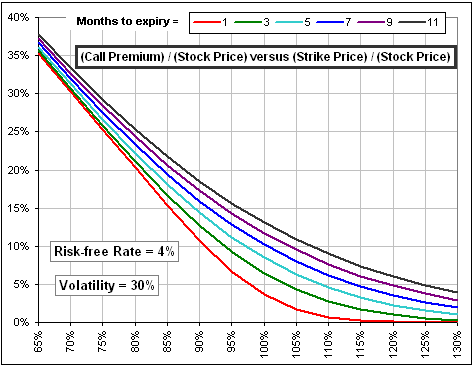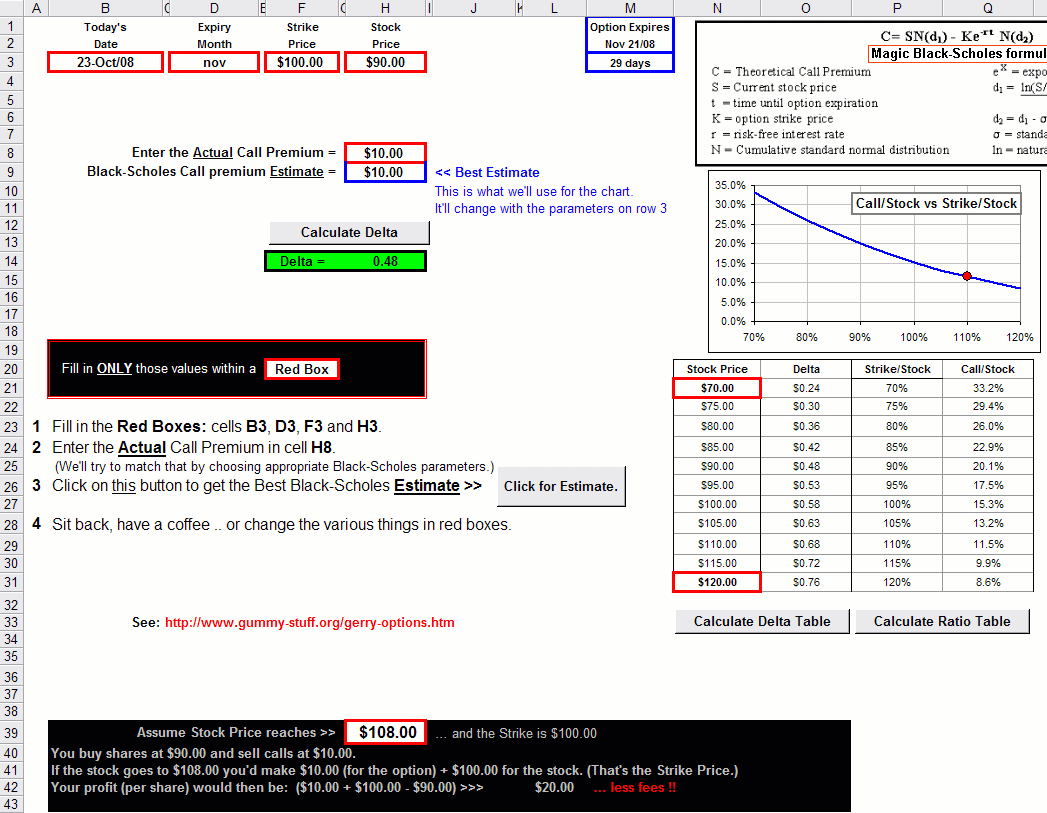| Covered Call Options |
There's this Option strategy that I'd like to talk about. It goes like this ...
>Options? Again!? I thought you don't do Options.
I don't. Now pay attention:
- You buy a bunch of shares of some stock, say IBM.
It'll cost you $90.78 a share. - You then sell Call Options which expire in one month, with a Strike Price of $100.
You'll get $2.90 for the Option. - If the Option is exercised within the next month, you'll get $100 for your stock (which you bought at $90.78).
You got yourself $2.90 + $100 and you spent $90.78 for a profit of: $12.12 in one month.
That's a return of 12.12/90.78 ... about 13% in a month. - If the Option is NOT exercised, you'd still have the stock and the $2.90 for having sold the Option.
That'll mean a gain of 2.90/90.78 ... about 3% in a month.
Yes, yes ... but wait until you hear the rest.
Here's a neat chart which shows the cost of a Call Option (as a percentage of the Stock Price): 
(It's an estimate obtained using the magic Black-Scholes formula.) It'll depend upon the Strike Price (as a percentage of the Stock Price) ... and the Volatility and some Risk-free rate. For the situation we described above, the Strike Price ($100) is about 110% of the Stock Price ($90.78)
>Wait! In the IBM example the Option Price was ... uh ...
Anyway, I'm not pushing Black-Scholes (which we may call BS, for short). |  |
>Are you still talking about Options with a Strike above the Stock Price?
Yes. Out-of-the-money by 10% ... and expiring in a month.
>But then you'd make about 10% if the option is NOT exercised and about 20% if it is, right?
Aha! You forgot fees. 
But, yes ... whether the option is exercised or not, your monthly gain should be significant.
>I thought you'd never consider out-of-the-money options.
I assume you're talking about this. But we're now talking about selling, not buying.
>And what if your stock drops like a rock?
Then you'll need this.
>Very funny ... but where do I find stocks with Call Options worth 10% of the Stock Price?
Shhh ... that's a secret ... 
>So where's the spreadsheet?
Okay, it goes like this:
- You type in today's Date, the month when the Call Option expires, the Strike price and the current Stock price.
- The spreadsheet tells you what the Option is worth ...according to Black-Scholes (BS).
Uh ... yes, and BS also needs some Risk-free Rate.
SO, you also type in the Actual value of the Option and then you ask the spreadsheet to vary the Volatility & Risk-free until its estimate is in good agreement.
After the spreadsheet has identified appropriate Volatility and Risk-free Rate, you can now play.
You can see how the ratio (Option price)/(Stock price) depends upon the ratio (Strike price)/(Stock price).
You can see what you'd make if the Stock price reaches a certain value at expiry.
It'll be (Option price + Strike price - Stock price) if your Option gets called away.
It'll be just (Option price) if it doesn't ... and you get to keep the stock.
Somebody has paid you for the privilege of buying your stock at the Strike price.
If the stock actually exceeds that Strike, they'll buy your stock. If not, they won't.
>But that's according to BS, right?
Exactly.
>So where's the spreadsheet?
| Calculations |
Just click on the picture to download the spreadsheet:
>On that spreadsheet, it looks like the Call/Stock ratio is 11.5%?
Yes, when Strike/Stock is 110%.
>That seems high.
Yes, it pretty high. However, somebuddy told me about some other guys ... like these:
- SDS:
- Strike/Stock = 110%
- Call/Stock = 9%
- DUG:
- Strike/Stock = 110%
- Call/Stock = 12%
- DIG:
- Strike/Stock = 110%
- Call/Stock = 14%
You took the words right outta my mouth.

>Uh ... what's that Delta stuff?
The Delta value for an option gives you an indication of how much the option price would change for a $1.00 change in the stock price.
If, for example, Delta = 0.25, then you might expect the option to increase by $0.25 if the stock price increased by $1.
In the example illustrated by the spreadsheet, Delta = 0.48.
So, if the stock increased from $90 to $91, one might expect the option to increase by $0.48, from $10 to $10.48.
>And if the stock price increased by $10, then the option would increase by $4.80, from $10 to $14.80, right?
That's a stretch. 

